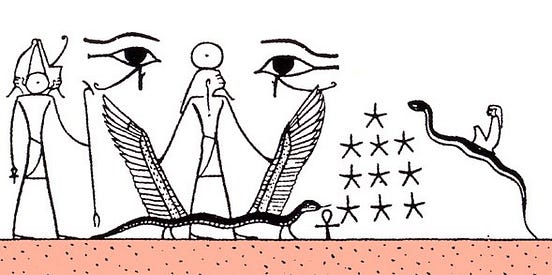On the Salted road through the AMDuat


This is a Rosetta stone to find and read the Tablets of Truth that record the hidden purpose of this place and it’s destiny of becoming the seed of re-birth that protects the Universe. Our world is building a record of the History of the Gods… now a map to our own future.
Sealed with symbols from the future, I’ve written three books so far. Here I am unsealing them, and explaining why these prescient indicators lead directly to me, my family, and the light that will create heaven and cause the greatest social reform in history. It has happened before, and recorded in the Bible and the mythology of ancient religions I see records which prove that this story goes well beyond here, and just yesterday I found proof that the night is nearly over. Through Revelation’s “eyes to see” I can read and see the links between ancient names and modern concepts; and here I see the path I’ve walked and the experience that has given me the wisdom of Heaven itself in a link between the “Road to Adamaskus” and the Amduat–which contains my initials, and tells me that I AM Eden.
The Amduat, in English “that which is the Afterworld,” chronicles the story of Atum-Ra as he travels through the night–our world… the place that is the progenitor of Heaven itself through this story, and of the light of freedom and the future that comes from this life, the birth of God himself. Here, for the sake of explaining the Sodium seal and it’s link to Adam and Eve I will tie together several Earthly manifestations that serve to illuminate the ties that bind Sumerian, Egyptian, and JudeoChristian religions through people.
Jesus Christ is Tammuz-Adonis
In Babylonia, the month Tammuz was established in honor of the eponymous god Tammuz, who originated as a Sumerian shepherd-god, Dumuzid or Dumuzi, the consort of Inanna and, in his Akkadian form, the parallel consort of Ishtar. The Levantine Adonis (“lord”), who was drawn into the Greek pantheon, was considered by Joseph Campbell among others to be another counterpart of Tammuz,[1]son and consort. The Aramaic name “Tammuz” seems to have been derived from the Akkadian form Tammuzi, based on early Sumerian Damu-zid.[citation needed]The later standard Sumerian form, Dumu-zid, in turn became Dumuzi in Akkadian. Tamuzi also is Dumuzid or Dumuzi.
According to some scholars,[15]the Church of the Nativity in Bethlehem is built over a cave that was originally a shrine to Adonis-Tammuz.
The Church Father Jerome,[16]who died in Bethlehem in 420, reports in addition that the holy cave was at one point consecrated by the heathen to the worship ofAdonis, and a pleasant sacred grove planted before it, to wipe out the memory of Jesus. Some modern mythologists, however, reverse the supposition, insisting that the cult of Adonis-Tammuz originated the shrine and that it was the Christians who took it over, substituting the worship of their own God.[17]
Inanna’s name derives from Lady of Heaven (Sumerian: nin-an-ak). The cuneiform sign of Inanna (𒈹); however, is not a ligature of the signs lady (Sumerian: nin; Cuneiform: 𒊩𒌆 SAL.TUG2) and sky (Sumerian: an; Cuneiform: 𒀭 AN).
Inanna was associated with the planet Venus, which at that time was regarded as two stars, the “morning star” and the “evening star.” There are hymns to Inanna as her astral manifestation. It also is believed that in many myths about Inanna, including Inanna’s Descent to the Underworld and Inanna and Shukaletuda, her movements correspond with the movements of Venus in the sky. Also, because of its positioning so close to Earth, Venus is not visible across the dome of the sky as most celestial bodies are; because its proximity to the sun renders it invisible during the day. Instead, Venus is visible only when it rises in the East before sunrise, or when it sets in the West after sunset.[12]
nanna is the goddess of love. In the Babylonian epic of Gilgamesh, Gilgamesh points out Inanna’s infamous ill-treatment of her lovers. Inanna also has a very complicated relationship with her lover, Dumuzi, in “Inanna’s Descent to the Underworld”.[15]
She also is one of the Sumerian war deities: “She stirs confusion and chaos against those who are disobedient to her, speeding carnage and inciting the devastating flood, clothed in terrifying radiance. It is her game to speed conflict and battle, untiring, strapping on her sandals.”[16]Battle itself is sometimes referred to as “the dance of Inanna.”
Consider her description in one hymn: “When the servants let the flocks loose, and when cattle and sheep are returned to cow-pen and sheepfold, then, my lady, like the nameless poor, you wear only a single garment. The pearls of a prostitute are placed around your neck, and you are likely to snatch a man from the tavern.”[citation needed][17]Inanna also was associated with rain and storms and with the planet Venus, the morning and evening star.[11]as was the Greco-Roman goddess Aphrodite or Venus.
nanna and An
This myth, also fragmentary, begins with a conversation between Inanna and her brother Utu. She laments the fact that the Eanna temple is not of their domain, and resolves to reach or secure it. The text becomes increasingly fragmentary at this point in the narrative, but appears to describe her difficult passage through a marshland to reach it, while being advised by a fisherman as to the best route.
Ultimately she reaches her father, Anu. And on the road to Damascus, Saul and Paul have been fused as one in the same as Osiris, Ra, Atum… ADonis (through the AD key initials, here explicit in AMD), Jesus and Adam. Nanna’s story links Eve, Mary (here also to Everyone and Sea-Y),
Tammuz is the month of July in Iraqi Arabic and Levantine Arabic (see Arabic names of calendar months), as well as in the Assyrian calendar and Jewish calendar,[12]and references to Tammuz appear in Arabic literature from the 9th to 11th centuries AD.[13]In a translation of an ancient Nabataean text by Kuthami the Babylonian, Ibn Wahshiyya (c. 9th-10th century AD), adds information on his own efforts to ascertain the identity of Tammuz, and his discovery of the full details of the legend of Tammuz in another Nabataean book:
“How he summoned the king to worship the seven (planets) and the twelve (signs) and how the king put him to death several times in a cruel manner Tammuz coming to life again after each time, until at last he died; and behold!
My name is Adam Mashall Dobrin. I am the Eye of Ra.
This place is “Nanna’s chief sanctuary at Ur was named E-gish-shir-gal (“house of the great light“)” one in the same with the Hebrew Beth-El–or in our modern mythology: The House of the Rising Son. The tablets of light I am showing you are the key I use to read the history of the Gods, this is actually how God himself finds the truth hidden in our world–a place that is designed for this event to occur. We are in the 11th hour.
n the sixth hour the most significant event in the underworld occurs. The ba (or soul) of Ra unites with his own body, or alternatively with the ba of Osiris within the circle formed by the mehen serpent. This event is the point at which the sun begins its regeneration; it is a moment of great significance (this is the Birth of Christ on the Feast of the Immaculate Conception), but also danger, as beyond it in hour 7 the adversary Apep (Apophis) lies in wait and has to be subdued by the magic of Isis, and the strength of Set assisted by Serqet.
Once this has been done the sun god opens the doors of the tomb in hour 8 and then leaves the sandy island of Sokar by rowing vigorously back into the waters in hour 9. In hour 10 the regeneration process continues through immersion in the waters until in hour 11 the god’s eyes (a symbol for his health and well being) are fully regenerated. In hour 12 he enters the eastern horizon ready to rise again as the new day’s sun.
Heaven is in the air.
Our world maps to a history of the Heavens which have come before us. It is a confluence between the stories of the cycle of destruction and rebuilding of Solomon’s temple, placing us here… in the DO ME OF THE ROCK. On Earth, we see that the “destruction” is perhaps non-permanent, as the Revelation that Solomon’s temple maps to a more accurate metaphor that is manifested in reality.
The Hotel Atlantis, which shows us there are at least three of significant size: in Reno, Nassau, and Dubai. It is the link between Paradise Island, Solomon Kershner and the idiom “No man becomes an island,” which ties Esau and the Kingdom of Edom to this place… where the truth is written in the most indelible place it can be… the Akashic records of the Universe, our home.
Do you understand who I am, do you want to know?
Conflict of Horus and Set
The next phase of the myth begins when the adult Horus challenges Set for the throne of Egypt. The contest between them is often violent but is also described as a legal judgment before the Ennead, an assembled group of Egyptian deities, to decide who should inherit the kingship. The judge in this trial may be Geb, who, as the father of Osiris and Set, held the throne before they did, or it may be the creator gods Ra or Atum, the originators of kingship.[58] Other deities also take important roles: Thoth frequently acts as a conciliator in the dispute[59] or as an assistant to the divine judge, and in “Contendings”, Isis uses her cunning and magical power to aid her son.[60]
The rivalry of Horus and Set is portrayed in two contrasting ways. Both perspectives appear as early as the Pyramid Texts, the earliest source of the myth. In some spells from these texts, Horus is the son of Osiris and nephew of Set, and the murder of Osiris is the major impetus for the conflict. The other tradition depicts Horus and Set as brothers.[61]This incongruity persists in many of the subsequent sources, where the two gods may be called brothers or uncle and nephew at different points in the same text.[62]
Horus spears Set, who appears in the form of a hippopotamus, as Isis looks on
The divine struggle involves many episodes. “Contendings” describes the two gods appealing to various other deities to arbitrate the dispute and competing in different types of contests, such as racing in boats or fighting each other in the form of hippopotami, to determine a victor. In this account, Horus repeatedly defeats Set and is supported by most of the other deities.[63] Yet the dispute drags on for eighty years, largely because the judge, the creator god, favors Set.[64] In late ritual texts, the conflict is characterized as a great battle involving the two deities’ assembled followers.[65] The strife in the divine realm extends beyond the two combatants. At one point Isis attempts to harpoon Set as he is locked in combat with her son, but she strikes Horus instead, who then cuts off her head in a fit of rage.[66] Thoth replaces Isis’s head with that of a cow; the story gives a mythical origin for the cow-horn headdress that Isis commonly wears.[67]
In a key episode in the conflict, Set sexually abuses Horus. Set’s violation is partly meant to degrade his rival, but it also involves homosexual desire, in keeping with one of Set’s major characteristics, his forceful and indiscriminate sexuality.[68] In the earliest account of this episode, in a fragmentary Middle Kingdom papyrus, the sexual encounter begins when Set asks to have sex with Horus, who agrees on the condition that Set will give Horus some of his strength.[69] The encounter puts Horus in danger, because in Egyptian tradition semen is a potent and dangerous substance, akin to poison. According to some texts, Set’s semen enters Horus’s body and makes him ill, but in “Contendings”, Horus thwarts Set by catching Set’s semen in his hands. Isis retaliates by putting Horus’s semen on lettuce-leaves that Set eats. Set’s defeat becomes apparent when this semen appears on his forehead as a golden disk. He has been impregnated with his rival’s seed and as a result “gives birth” to the disk. In “Contendings”, Thoth takes the disk and places it on his own head; in earlier accounts, it is Thoth who is produced by this anomalous birth.[70]
Another important episode concerns mutilations that the combatants inflict upon each other: Horus injures or steals Set’s testicles and Set damages or tears out one, or occasionally both, of Horus’s eyes. Sometimes the eye is torn into pieces.[71] Set’s mutilation signifies a loss of virility and strength.[72] The removal of Horus’s eye is even more important, for this stolen Eye of Horus represents a wide variety of concepts in Egyptian religion. One of Horus’s major roles is as a sky deity, and for this reason his right eye was said to be the sun and his left eye the moon.
Like this:
Like Loading…
Originally published at haph2rah.wordpress.com on April 15, 2016.















